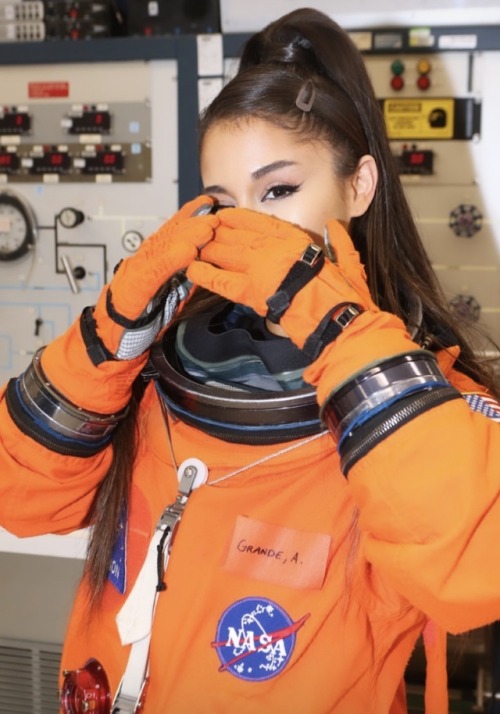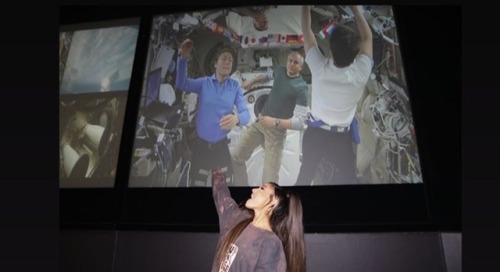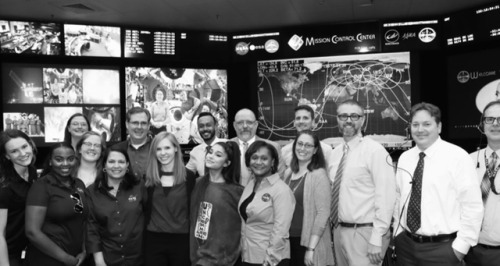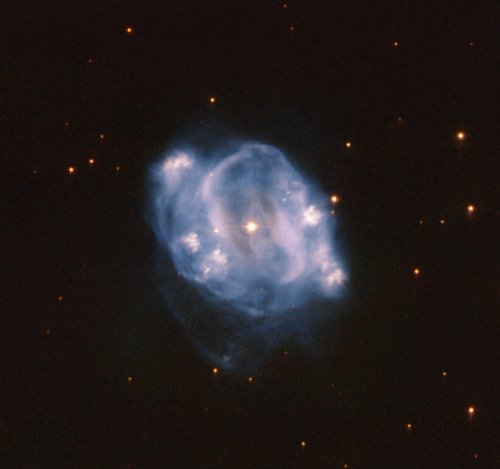100 Days In Houston
100 Days in Houston
A lot can happen in 100 days...
At our Johnson Space Center, located in Houston, it has been busy since July 10. Here are six things that have been going on in Houston with our astronauts, the International Space Station and our next great telescope! Take a look:
1. Our James Webb Space Telescope is Spending 100 Days in a Freezing Cold Chamber
Imagine seeing 13.5 billion light-years back in time, watching the birth of the first stars, galaxies evolve and solar systems form…our James Webb Space Telescope will do just that once it launches in 2019.

Webb will be the premier observatory of the next decade, studying every phase in the cosmic history of our universe, ranging from the first luminous glows after the Big Bang, to the formation of solar systems.
On July 10, the Webb telescope entered Johnson Space Center’s historic Chamber A for its final cryogenic test that lasts about 100 days behind a closed giant vault-like door.
Why did we put Webb in this freezing cold chamber? To ensure it can withstand the harsh environment it will experience in space.

The telescope has been in a space-like environment in the chamber, tested at cryogenic temperatures. In space, the telescope must operate at extremely cold temperatures so that it can detect infrared light – heat radiation -- from faint, distant objects.

To keep the telescope cold while in space, Webb has a sunshield the size of a tennis court, which blocks sunlight (as well as reflected light from the Earth and Moon). This means that the sun-facing side of the observatory is incredibly hot while the telescope-side remains at sub-freezing temperatures.
2. Our 12 new astronaut candidates reported to Houston to start training

Our newest class of astronaut candidates, which were announced on June 7, reported for training on August 13. These candidates will train for two years on International Space Station systems, space vehicles and Russian language, among many other skills, before being flight-ready.
3. Our Mission Control Center operated for 2,400 hours

While astronauts are in space, Mission Control operates around the clock making sure the crew is safe and the International Space Station is functioning properly. This means workers in Mission Control work in three shifts, 7 a.m. – 4 p.m., 3 p.m. – midnight and 11 p.m. – 8 a.m. This includes holidays and weekends. Day or night, Mission Control is up and running.
4. Key Teams at Johnson Space Center Continued Critical Operations During Hurricane Harvey

Although Johnson Space Center closed during Hurricane Harvey, key team members and critical personnel stayed onsite to ensure crucial operations would continue. Mission Control remained in operation throughout this period, as well as all backup systems required to maintain the James Webb Space Telescope, which is at Johnson for testing, were checked prior to the arrival of the storm, and were ready for use if necessary.
5. Crews on the International Space Station conducted hundreds of science experiments.

Mission Control at Johnson Space Center supported astronauts on board the International Space Station as they worked their typical schedule in the microgravity environment. Crew members work about 10 hours a day conducting science research that benefits life on Earth as well as prepares us for travel deeper into space.

The space station team in Houston supported a rigorous schedule of launches of cargo that included supplies and science materials for the crew living and working in the orbiting laboratory, launched there by our commercial partners.
6. Two new crews blasted off to space and a record breaking astronaut returned from a stay on space station

Houston is home to the Astronaut Corps, some of whom end up going out-of-this-world. On July 28, NASA Astronaut Randy Bresnik launched to the International Space Station alongside Italian astronaut Paolo Naspoli and Russian cosmonaut Sergey Ryazanskiy. Joining them at the International Space Station were NASA Astronauts Joe Acaba and Mark Vande Hei who launched September 12 with Russian cosmonaut Alexander Misurkin.

When NASA Astronaut Peggy Whitson landed with crewmates Jack Fischer of NASA and Fyoder Yurchikhin of Roscosmos, she broke the record for the most cumulative time in space by a U.S. astronaut. She landed with over 650 days of cumulative flight time and more than 53 hours of spacewalk time. Upon her return, the Human Research Program in Houston studies her health and how the human body adapted to her time in space.
Learn more about the Johnson Space Center online, or on Facebook, Twitter or Instagram.
Make sure to follow us on Tumblr for your regular dose of space: http://nasa.tumblr.com.
More Posts from Nasa and Others
Why We Study the Sun-Earth Connection – Explained Through Songs
We're launching a new mission to the International Space Station to continue measurements of the Sun's energy reaching Earth.

The Total and Spectral solar Irradiance Sensor (TSIS-1) will precisely measure the total amount of sunlight that falls on Earth and how that light is distributed among different wavelengths, including the ultraviolet, visible and infrared. This will give us a better understanding of Earth’s primary energy supply and help improve models simulating Earth’s climate.
1. You are my sunshine, my only sunshine. You make me happy when skies are gray.

The Sun is Earth's sunshine and it does more than make us happy; it gives us life. Our Sun's energy drives our planet's ocean currents, seasons, weather and climate. Changes in the Sun also alter our climate in at least two ways.
First, solar radiation has a direct effect where it heats regions of Earth, like our oceans, land, and atmosphere. Second, the solar radiation can cause indirect effects, such as when sunlight interacts with molecules in the upper atmosphere to produce ozone which can affect human health.

Earth’s energy system is in a constant dance to maintain a balance between incoming energy from the Sun and outgoing energy from Earth to space, which scientists call Earth’s energy budget. If you have more energy absorbed by the Earth than leaving it, its temperature increases and vice versa. Because the Sun is Earth's fundamental energy source and only sunshine, we need a quantitative record of the Sun's solar energy output. TSIS-1 will provide the most accurate measurements ever made of sunlight as seen from above Earth’s atmosphere.
2. You're hot then you're cold…You're in then you're out. You're up then you're down.

The energy flow between the Earth and Sun's connection is not a constant thing. The Sun can be fickle, sometimes it puts out slightly more energy and some years less. Earth is no better. The Earth absorbs different amounts of the Sun's energy depending on many factors, such as the presence of clouds and tiny particles in the atmosphere called aerosols.
What we do know is that the Sun's cycle is about 11 years rolling through periods of quiet to times of intense activity. When the Sun is super-intense it releases explosions of light and solar material. This time is a solar maximum.
When the Sun is in a quiet state this period is called the solar minimum.

Over the course of one solar cycle (one 11-year period), the Sun’s total emitted energy varies on average at about 0.1 percent. That may not sound like a lot, but the Sun emits a large amount of energy – 1,361 watts per square meter. Even fluctuations at just a tenth of a percent can affect Earth. That's why TSIS-1 is launching: to help scientists understand and anticipate how changes in the Sun will affect us on Earth.
3. You're so vain. You probably think this climate model is about you.

Scientists use computer models to interpret changes in the Sun’s energy input. If less solar energy is available, scientists can gauge how that affects Earth’s atmosphere, oceans, weather and seasons by using computer simulations. But the Sun is just one of many factors scientists use to model Earth’s climate. A lot of other factors come into play in addition to the energy from the Sun. Factors like greenhouse gases, clouds scattering light and small particles in the atmosphere called aerosols all can affect Earth’s climate so they all need to be included in climate models. So, while we need to measure the total amount of energy from the Sun, we also need to understand how these other factors alter the amount of energy reaching Earth's surface and affect our climate.
4. Someday we'll find it, the rainbow connection. The lovers, the dreamers and me.

We receive the Sun's energy in many different wavelengths, including visible light (rainbows!) as well as light we can't see like infrared and ultraviolet wavelengths. Each color or wavelength of light from the Sun affects Earth’s atmosphere differently.
For instance, ultraviolet light from the Sun can affect Earth's ozone. High in the atmosphere is a layer of protective ozone gas. Ozone is Earth’s natural sunscreen, absorbing the Sun’s most harmful ultraviolet radiation and protecting living things below. But ozone is vulnerable to certain gases made by humans that reach the upper atmosphere. Once there, they react in the presence of sunlight to destroy ozone molecules. Currently, several satellites from us and the National Oceanic and Atmospheric Administration (NOAA) track the ozone in the upper atmosphere and the solar energy that drives the photochemistry that creates and destroys ozone. Our new instrument, TSIS-1, will join that fleet with even better accuracy.

TSIS-1 will see different types of ultraviolet (UV) light, including UV-B and UV-C. Each plays a different role in the ozone layer. UV-C rays are essential in creating ozone. UV-B rays and some naturally occurring chemicals regulate the abundance of ozone in the upper atmosphere. The amount of ozone is a balance between these natural production and loss processes.
TSIS-1 data of the Sun's UV energy will help improve computer models of the atmosphere that need accurate measurements of sunlight across the ultraviolet spectrum to model the ozone layer correctly. While UV light represents a tiny fraction of the total sunlight that reaches the top of Earth's atmosphere, it fluctuates from 3 to 10 percent, a change that, in turn causes small changes in the chemical composition and thermal structure of the upper atmosphere.
This is just one of the important applications of TSIS-1 measurements. TSIS-1 will measure how the Sun's energy is distributed over 1,000 different wavelengths.
5. Every move you make…every step you take, I'll be watching you.

TSIS-1 will continue our nearly 40 years of closely studying the total amount of energy the Sun sends to Earth from space. We've previously studied this 'total solar irradiance' with nine previous satellites, currently with Solar Radiation and Climate Experiment, (SORCE).

NASA’s SORCE collected this data on the total amount of the Sun’s radiant energy throughout Sept. 2017. The satellite actually detected a dip in total irradiance – or the total amount of energy from the Sun- during the month’s intense solar activity.
But there's still very much we don't know about total solar irradiance. We do not know how it varies over longer timescales. Longer term observations are especially important because scientists have observed unusually quiet magnetic activity from the Sun for the past two decades with previous satellites. During the last prolonged solar minimum in 2008-2009, our Sun was the quietest it has ever been since we started observations in 1978. Scientists expect the Sun to enter a solar minimum within the next three years, and TSIS-1 will be primed to take measurements of the next minimum and see if this is part of a larger trend.
For all the latest Earth updates, follow us on Twitter @NASAEarth or Facebook.
Make sure to follow us on Tumblr for your regular dose of space: http://nasa.tumblr.com.
Photos of the eclipse are okay and just as neat to look at? Will NASA post to twitter. Will the Space station take photos also?
Yes, we will be posting a ton of photos and you can add to them as well! https://www.flickr.com/groups/nasa-eclipse2017/ I agree, the photos are incredibly cool!
Celebrating 10 Years of Revolutionary Solar Views
Twin spacecraft give humanity unprecedented views of the entire sun at one time, traveling to the far side of our home star over the course of a 10-year mission.

These two spacecraft are called STEREO, short for Solar and Terrestrial Relations Observatory. Launched on Oct. 25, 2006, and originally slated for a two-year mission, both spacecraft sent back data for nearly eight years, and STEREO-A still sends information and images from its point of view on the far side of the sun.

STEREO watches the sun from two completely new perspectives. It also provides information invaluable for understanding the sun and its impact on Earth, other worlds, and space itself – collectively known as space weather. On Earth, space weather can trigger things like the aurora and, in extreme cases, put a strain on power systems or damage high-flying satellites.
Because the rest of our sun-watching satellites orbit near our home planet, STEREO’s twin perspectives far from Earth give us a unique opportunity to look at solar events from all sides and understand them in three dimensions.

We use data from STEREO and other missions to understand the space environment throughout the solar system. This helps operators for missions in deep space prepare for the sudden bursts of particles and magnetic field that could pose a danger to their spacecraft.

STEREO has also helped us understand other objects in our solar system – like comets. Watching how a comet’s tail moves gives us clues about the constant stream of particles that flows out from the sun, called the solar wind.

STEREO is an essential piece of our heliophysics fleet, which includes 17 other missions. Together, these spacecraft shed new light on the sun and its interaction with space, Earth, and other worlds throughout the solar system.
To celebrate, we’re hosting a Facebook Live event on Wednesday, Oct. 26. Join us at noon ET on the NASA Sun Science Facebook page to learn more about STEREO and ask questions.
Learn more about how NASA studies the sun at: www.nasa.gov/stereo
Follow us on Tumblr for your regular dose of space: http://nasa.tumblr.com
Which Landsat Image Do You Love?
Feeling competitive? We’ve got a game for you to play in! Tournament Earth: The Landsat Games is happening right now, and as we get to the final entries, the competition is heating up.

You can help us pick the winner by voting for one of the remaining four Landsat images of our home planet! Our competition started with 32 images, divided into categories by what they show: land, water, ice & snow, and human impact.
So, what do you think? Which one of these images is going for gold?
Land
First up, we have an image of the Markha River and surrounding Central Siberian Plateau, acquired in 2020 by Landsat 8. The hypnotic undulations of striping across the landscape carried this image to victory over the rest of the Land images -- a particularly tough category, given that these images all come from Landsat.

Water
It’s not all land, though! The bright blues and greens of this false-color image of the Atchafalaya Delta in Louisiana helped carry it to victory in the Water category. The image, taken in 2020 by Landsat 8, shows a region that’s subject to erosion of land by wind and rising sea levels.

Ice & Snow
Brrr! Did it get cold in here? That’s the finalist from the Ice and Snow category, an image of sea ice around Russia’s New Siberian Islands. The image, collected by Landsat 8 in June 2016, shows sea ice during its annual seasonal breakup.

Human Impact
Humans have been shaping the planet around us for hundreds of years. Some changes, like rice fields in the Sacramento Valley, are visible from space. Landsat 8 collected this false-color image of flooded rice fields in December 2018.

So, now it’s up to you! Which image is your favorite? There can only be one winner of Tournament Earth: The Landsat Games. Get your vote in, and then get ready to watch as we launch the next Landsat satellite, Landsat 9, in September.

The Landsat mission is a partnership between us at NASA and the U.S. Geological Survey. Together, we’ve been using Landsat satellites to collect nearly 50 years of images of our home planet.
Make sure to follow us on Tumblr for your regular dose of space.
Astronaut in the house!
Air Force Colonel and NASA Astronaut Nick Hague is back from his seven month stay aboard the space station and ready to answer your questions in today's Tumblr Answer Time!
Let's get started.




Ariana Grande got some space at N-A-S-A. Get yours too.
Make sure to follow us on Tumblr for your regular dose of space: http://nasa.tumblr.com.
Curiosity Rover: Five Years on Mars
The evening of August 5, 2012…five years ago…our Mars Curiosity rover landed on the Red Planet.

Arriving at Mars at 10:32 p.m. PDT (morning of Aug 6 EDT), this rover would prove to be the most technologically advanced rover ever built.

Curiosity used a series of complicated landing maneuvers never before attempted.

The specialized landing sequence, which employed a giant parachute, a jet-controlled descent vehicle and a daring “sky crane” maneuver similar to rappelling was devised because testing and landing techniques used during previous rover missions could not safely accommodate the much larger and heavier rover.
Curiosity’s mission: To determine whether the Red Planet ever was, or is, habitable to microbial life.

The car-size rover is equipped with 17 cameras, a robotic arm, specialized instruments and an on-board laboratory.

Let’s explore Curiosity’s top 5 discoveries since she landed on Mars five years ago…
1. Gale Crater had conditions suitable for life about 3.5 billion years ago

In 2013, Curiosity’s analysis of a rock sample showed that ancient Mars could have supported living microbes. Scientists identified sulfur, nitrogen, hydrogen, oxygen, phosphorus and carbon – some of the key chemical ingredients for life – in the powder Curiosity drilled out of a sedimentary rock near an ancient stream bed in Gale Crater.

Later, in 2014, Curiosity discovered that these conditions lasted for millions of years, perhaps much longer. This interpretation of Curiosity’s findings in Gale Crater suggests ancient Mars maintained a climate that could have produced long-lasting lakes at many locations on the Red Planet.
2. Organic molecules detected at several locations

In 2014, our Curiosity rover drilled into the Martian surface and detected different organic chemicals in the rock powder. This was the first definitive detection of organics in surface materials of Mars. These Martian organics could either have formed on Mars or been delivered to Mars by meteorites.

Curiosity's findings from analyzing samples of atmosphere and rock powder do not reveal whether Mars has ever harbored living microbes, but the findings do shed light on a chemically active modern Mars and on favorable conditions for life on ancient Mars.
3. Present and active methane in Mars’ atmosphere

Also in 2014, our Curiosity rover measured a tenfold spike in methane, an organic chemical, in the atmosphere around the planet. This temporary increase in methane tells us there must be some relatively localized source.

Researchers used Curiosity’s onboard Sample Analysis at Mars (SAM) laboratory a dozen times in a 20-month period to sniff methane in the atmosphere. During two of those months, in late 2013 and early 2014, four measurements averaged seven parts per billion.
4. Radiation could pose health risks for humans

Measurements taken by our Curiosity rover since launch have provided us with the information needed to design systems to protect human explorers from radiation exposure on deep-space expeditions in the future. Curiosity’s Radiation Assessment Detector (RAD) was the first instrument to measure the radiation environment during a Mars cruise mission from inside a spacecraft that is similar to potential human exploration spacecraft.

The findings indicate radiation exposure for human explorers could exceed our career limit for astronauts if current propulsion systems are used. These measurements are being used to better understand how radiation travels through deep space and how it is affected and changed by the spacecraft structure itself. This, along with research on the International Space Station are helping us develop countermeasures to the impacts of radiation on the human body.
5. A thicker atmosphere and more water in Mars past

In 2015, Curiosity discovered evidence that has led scientists to conclude that ancient Mars was once a warmer, wetter place than it is today.
To produce this more temperate climate, several researchers have suggested that the planet was once shrouded in a much thicker carbon dioxide atmosphere. You may be asking…Where did all the carbon go?

The solar wind stripped away much of Mars’ ancient atmosphere and is still removing tons of it every day. That said, 3.8 billion years ago, Mars might have had a moderately dense atmosphere, with a surface pressure equal to or less than that found on Earth.
Our Curiosity rover continues to explore the Red Planet today. On average, the rover travels about 30 meters per hour and is currently on the lower slope of Mount Sharp.

Get regular updates on the Curiosity mission by following @MarsCuriosity on Twitter.
Make sure to follow us on Tumblr for your regular dose of space: http://nasa.tumblr.com
How has being in space changed your perspective of life on Earth?
7 Things That Happen When You Go To Space
Told Through Astronaut Scott Kelly’s Tweets
Astronaut Scott Kelly is currently spending a year in space. Most expeditions to the space station last four to six months. By doubling the length of this mission, researchers hope to better understand how the human body reacts and adapts to long-duration spaceflight. During this one-year mission, Kelly is also participating in the Twins Study. While Kelly is in space, his identical twin brother, retired NASA Astronaut Mark Kelly, will participate in a number of comparative genetic studies.
Here are a few things that happen when astronauts go to the space station:
1. Your personal hygiene takes on a different form:


2. Sleeping arrangements might take some getting used to:



3. Internet services will remind you of the 90s:

4. You never have to do laundry:


5. You get to become immersed in a range of different cultures:

6. All of your water is recycled…yes…that means urine too:


7. You get to see the Earth like never before:



Follow Astronaut Scott Kelly’s Year in Space mission on Facebook, Twitter and Instagram.
Make sure to follow us on Tumblr for your regular dose of space: http://nasa.tumblr.com

Twinkle, twinkle, little star, How I wonder what you are. Up above the world so high, Like a diamond in the sky. 🌟 The final stages of a star’s life allow us a glimpse into the future of our own solar system. This image from our Hubble Space Telescope shows what’s left of a star 10,000 light-years from Earth.
A star like our Sun will, at the end of its life, transform into a red giant. The core of the star will eventually collapse in on itself, ejecting the surface layers outward. After that, all that remains of the star is what we see here: glowing outer layers surrounding a white dwarf star. In just a few thousand years they will have dissipated, and all that will be left to see is the dimly glowing white dwarf. More on this image, here.
Make sure to follow us on Tumblr for your regular dose of space: http://nasa.tumblr.com
Explore the universe and discover our home planet with the official NASA Tumblr account
1K posts